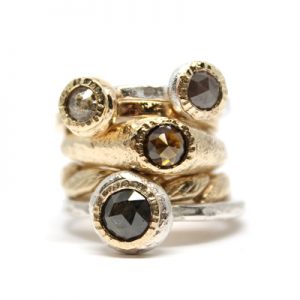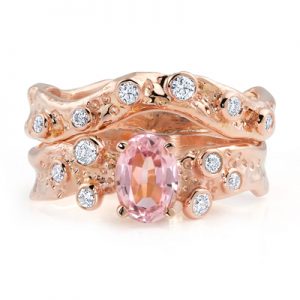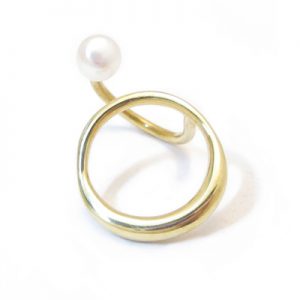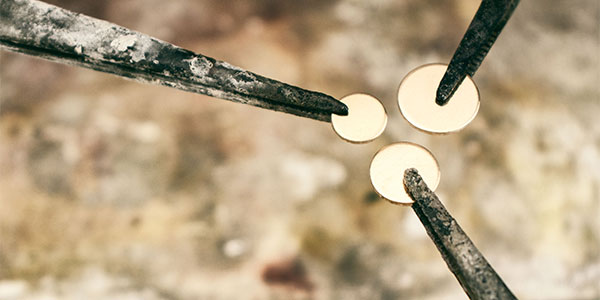Gold is seductive. The luminous metal has inspired artists and wearers throughout human history. This reference article will explore different golden materials used in the jewelry arts.
Over the centuries, metallurgists and metalsmiths developed different types of gold-colored material to meet a variety of needs. A damaged jewelry piece made of pure gold probably inspired one of our metal-loving forebears to experiment. Gold is strengthened by adding a little silver and zinc, for example. Jewelers have adopted a number of golden alloyed metals and developed more affordable layered metals to use for material as well. LEARN MORE ABOUT ALLOYS IN JEWELRY >>
In this article, we will describe 9 types of gold and golden-hued metals found in jewelry making. It is important for contemporary metalsmiths to understand the strengths and weaknesses of each material choice.
We'll cover:
Elemental Gold - 24kt gold
Alloyed Gold Metals - 10kt, 14kt, 18kt / yellow, white, rose gold
Layered Gold Metals - gold-filled, gold-plated, Vermeil, Mokume Gane

Diamond Rings - 14kt Yellow Gold,
14kt White Gold, Rose Cut Diamonds
Elemental Metal
24 karat pure gold
24 karat gold is the element in its purest form. It is a rich, aqueous yellow color. In antiquity, metalsmiths used high karat or pure gold in jewelry for royalty. However, the items are so pliable you can bend them with your fingers and scratch them with your nails. Pure gold is easy to dent and even stretch if the pieces are thin. This fragility is not practical. Today, 24 karat gold (or close to it) is most frequently used for surface applications of plating or thin gold foil sheets, sometimes called gold leaf. Gold foil is bonded to other metals for an ornamental effect, often in feathered, papery designs. One technique from Korea called keum-boo involves bonding gold foil to silver through a heating and burnishing process.
Alloyed Metals
Yellow Gold Alloys
Pure gold is mixed with other metal elements while in the molten state to create alloys with different properties such as strength and various colors. The most common type of gold alloy is yellow in color and contains silver and zinc. The resulting material is more durable for long-lasting jewelry that is easy to care for. It also makes the material somewhat less expensive.
SHOP 14K GOLD JEWELRY SUPPLIES >>
The karatage system describes the ratio of pure gold to other metals in the alloys. In the United States, for example, the standard for solid gold jewelry is 14 karat gold. If you apply the ratio 14/24 karats, you can calculate that it is 58.3% pure gold. It is the most common alloy in our country but buyers should note that other alloys are available with lower and higher karatages. Jewelers are required to disclose the karats of the material on finished pieces of jewelry. A quality mark or hallmark is stamped or engraved on the piece with the karatage. Other examples at the low and high end of the market are 10 karat gold (10/24), which is 41.6% pure, and 18 karat gold (18/24), which is 75% pure gold. The karatage of the alloy obviously affects the price points of the finished items. It also affects the color of the metal with higher karat alloys being more yellow and lower karat varieties appearing more muted.
Colored Gold Alloys
Whatever the intensity of the color, we usually think of gold as a yellow-toned metal. However, you can get a range of gold karatage in different colors if you vary the added metals in the alloys. White gold contains nickel, for example. The addition of copper to a gold alloy will result in the rose gold that is so trendy today. With a little less copper and a different ratio of silver and zinc, it is possible to alloy green gold.

18K Rose Gold, Pink Tourmaline, Diamonds
Copper Based Alloys
Brass & Bronze are both primarily made of copper. These base metals have the highly prized golden tone that is popular in adornment; but, they are made from low-cost metals and frequently used for costume jewelry. Antique jewelry items were often made from bronze. Brass has become more common in modern times. Both are prone to tarnish and may turn the wearer's skin green. The discoloration is a harmless reaction for most people, but some individuals are allergic to these materials and should avoid them. Polishing copper-based alloys will remove tarnish. Or, plating either alloy with other metals will improve the finish and delay tarnish.
Brass
Brass is a bright yellow or reddish alloy made up of copper and zinc. There are so many combinations of brass alloys that European Norm Standards have more than 60 types of brass on record. The two specific variations described below are most common for jewelry making. Brass is a low-cost, attractive metal with a golden tone and it is malleable and easy to manipulate so it can be fabricated or cast. Unfortunately, soldering brass creates a visible seam that needs to be covered through design construction or plating for aesthetic reasons.
- Red brass = 15% zinc and 85% copper. The high level of copper in red brass creates a red tone in the alloy.
- Yellow brass = 33% zinc and 67% copper. Yellow brass is bright and shinier than red brass.
Bronze
Bronze consists of 12% tin (or other metals) and 88% copper. The resulting alloy has a warm, brown tone and is quite brittle. Therefore, bronze items are cast into thick forms to avoid weak points that could break. Fabricating bronze pieces from sheet and wire is not practical. Besides the beautiful golden color of bronze, an interesting fact is that it expands slightly when it goes from a molten state to a solid. Jewelers must plan for this expansion when casting.
Layered Metals
Layered metal types of gold material are more affordable, durable alternatives to gold alloys. Most layered golden materials consist of a substantial core material with a thin surface layer of gold. These materials cannot be cast since the layers are distinct.
Gold-Filled
Two or three distinct layers form gold-filled material. The core metal is usually jewelers' brass (10% zinc and 90% copper); though in the past, sterling silver was sometimes used instead. Single clad gold-filled has all the gold content in a single layer on one side. Double clad gold-filled splits the gold content into surface layers on both sides of the material. Heat and pressure are applied to bond the gold alloy to one or both surfaces of the brass core. Sheet and wire made from the raw gold-filled material are sold to jewelry manufacturers for use in designs.
SHOP GOLD-FILLED JEWELRY SUPPLIES >>
Gold-filled contains 5% or 1/20 gold alloy by weight. This 5% must also be described by the karatage of the gold alloy on the surface. Most gold-filled is 12kt or 14kt gold-filled. Products are identified as 14/20 Gold-filled or 12/20 Gold-Filled. Alternatively, 14kt Gold-Filled or 12kt Gold-Filled are also acceptable. Quality marks may further abbreviate to 14/20 GF or 12/20 GF.
Rolled gold is a watchmaking material that is often confused with gold-filled. Thin sheets of gold are fused to a brass core to make rolled-gold. However, rolled gold is only required to be 1/40 gold by weight, making the gold content much lower than gold-filled.
Gold-Plated or Gold-Dipped

18kt Gold-Plated Brass, Freshwater Pearl
Gold-plated items have less gold compared to gold-filled and rolled-gold. Flash gold plating is approximately 0.05% of gold applied over a base metal, such as brass. It has a limited lifespan and the gold layer can wear off with time, however, gold-plated items are still popular jewelry choices for limited budgets.
Electroplating
Electroplating is the process of creating a layer of metal on the surface of an object. When electroplating, an electric current negatively charges the base metal that is submerged in a solution containing positively charged gold ions. These positive gold ions are attracted to the negative charge of the core metal, slowly forming a layer of gold on the surface.
Vermeil
By US law, Vermeil has a base of sterling silver and must contain a minimum of two microns of gold alloy layered over it. Vermeil has a thicker gold layer than gold plated items and the plating is applied over sterling. The material is entirely made of precious metal. The thicker plating on vermeil makes the material more durable than flash plating, but it is still less durable than gold-filled.
Mokume Gane
Another form of decorative layering called Mokume Gane creates interesting patterned material for decorative use. Denbei Shoami developed the process in Japan in the 1600's for Samurai sword hilts; but the technique didn't make its way to the United States until the 1970's. Metalsmiths make Mokume Gane billets from many different metals including gold, silver, copper, and brass, among others. The billets of fused metals are pulled into a wide variety of patterns and colors. Mokume Gane literally means "wood grained metals" and jewelry made from these sheets resemble just that.
Each of these types of gold has its place in the jewelry market. The variety gives consumers options at different price points. In the jewelry field, it is important that we offer transparency to honestly describe the materials used in every piece of adornment.
You may also find our blog Types of Silver - Learn the Grades of Silver Alloys & Purity in Jewelry interesting.
About Halstead
Got questions? Email us at [email protected]. We’d love to hear from you. Sorry, studio support is not available by phone. Emails only, please.
Continue Reading:
How to Sweat Solder 14kt Gold to Sterling Silver
What Does Gold-Filled Mean - 6 Things You May Not Know








